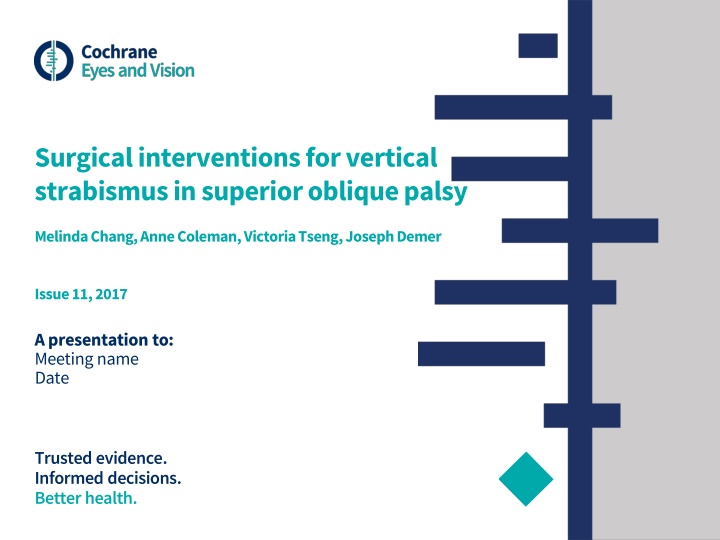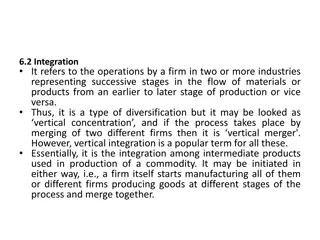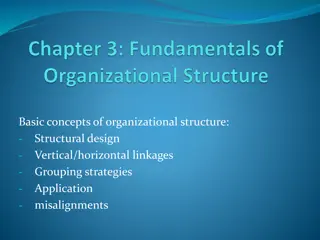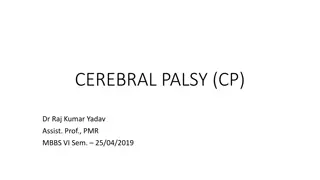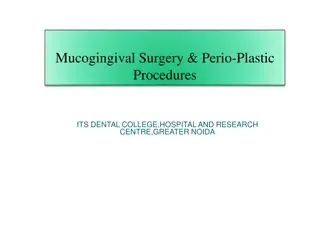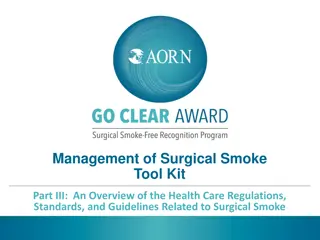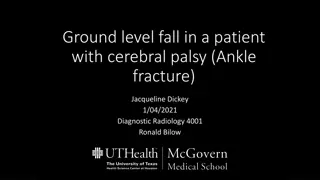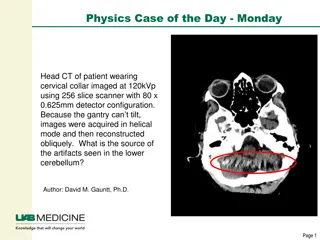Surgical Interventions for Vertical Strabismus in Superior Oblique Palsy: A Review
Binocular misalignment in superior oblique palsy often requires surgical interventions to address vertical strabismus, which can lead to visual issues and neck muscle problems. This review assessed the effects of various surgical treatments on individuals with this condition. Despite limited data preventing a conclusive recommendation, differences in outcomes between procedures were noted. The studies analyzed various surgical techniques but lacked data on the primary outcome of postoperative surgical success. More research is needed to determine the optimal approach for managing superior oblique palsy.
Download Presentation

Please find below an Image/Link to download the presentation.
The content on the website is provided AS IS for your information and personal use only. It may not be sold, licensed, or shared on other websites without obtaining consent from the author.If you encounter any issues during the download, it is possible that the publisher has removed the file from their server.
You are allowed to download the files provided on this website for personal or commercial use, subject to the condition that they are used lawfully. All files are the property of their respective owners.
The content on the website is provided AS IS for your information and personal use only. It may not be sold, licensed, or shared on other websites without obtaining consent from the author.
E N D
Presentation Transcript
Surgical interventions for vertical strabismus in superior oblique palsy Melinda Chang, Anne Coleman, Victoria Tseng, Joseph Demer Issue 11, 2017 A presentation to: Meeting name Date Trusted evidence. Informed decisions. Better health.
Table of Contents 01 Background 02 Typesof studies 03 Key results 04 Tables (Risk of Bias/Forest Plots) 05 Conclusions 06 Acknowledgements
Background Vertical binocular misalignment (strabismus) is a main feature of superior oblique palsy that could be treated by surgical interventions. Vertical strabismus could lead to diplopia oranomalous head posture and then permanent contracture of the neck muscles. Objective: To assess the relative effects of surgical treatments compared with another surgical intervention, non-surgical intervention, or observation for vertical strabismus in people with superior oblique palsy.
Types of studies Participants 2 randomized controlled trials; 45 children and adults of both genders Interventions inferior oblique myectomyVERSUSinferior oblique recession AND inferioroblique disinsertionVERSUS anteriortransposition
Key results Because the two studies included in this review compared the effects of two different pairs of surgical procedures, we were unable to combine data in a meta-analysis for any outcome targeted for this review. Furthermore, neither of the studies provided data on our primary outcome, the proportion of participants with postoperative surgical success, defined as hypertropialess than 3 PD in primary gaze.The limited data preclude any conclusion regarding optimal surgical treatment of superior oblique palsy.
Tables Tables Flow diagram
Tables Tables Risk of Bias
Conclusions We found no trials that evaluated our primary outcome, proportion of participants with surgical success, defined as hypertropia less than 3 prism diopters (PD) in primary gaze. Although the average reduction of hypertropia in primary gaze was found to be greater in inferior oblique myectomy than in recession (Shipman 2003), and also greater in inferior oblique anterior transposition than in disinsertion (Yanyali 2001), this outcome measure is problematic because it may depend on the magnitude of preoperative deviation. Additionally, a larger decrease in hypertropia may or may not be desirable, depending on the patient s preoperative vertical deviation. A patient with a small preoperative hypertropia may be significantly symptomatic if overcorrected.
Conclusions (continued) The two included trials both compared two different procedures to weaken the ipsilateral inferior oblique muscle. We did not find any trials comparing other types of surgeries for superior oblique palsy. Because of the paucity of data, small number of outcomes reported, and methodological limitations causing potential biases in the two studies included in this review, we are unable to identify the optimal surgical treatment for vertical strabismus in superior oblique palsy. This finding highlights the need for larger, well-designed comparative studies to address this important question.
Acknowledgements Cochrane Eyes and Vision US Satellite, funded by the National Eye Institute, National Institutes of Health Cochrane Eyes and Vision Editorial Base, funded by the UK National Health Service Research and Development Programme Systematic review conducted by Melinda Chang, Anne Coleman, Victoria Tseng, Joseph Demer in collaboration with methodologists at the Cochrane Eyes and Vision US Satellite Review citation Chang MY,Coleman AL,Tseng VL,Demer JL.Surgical interventions for vertical strabismus in superior oblique palsy.Cochrane Database of Systematic Reviews2017, Issue11. Art. No.: CD012447. DOI: 10.1002/14651858.CD012447.pub2.
